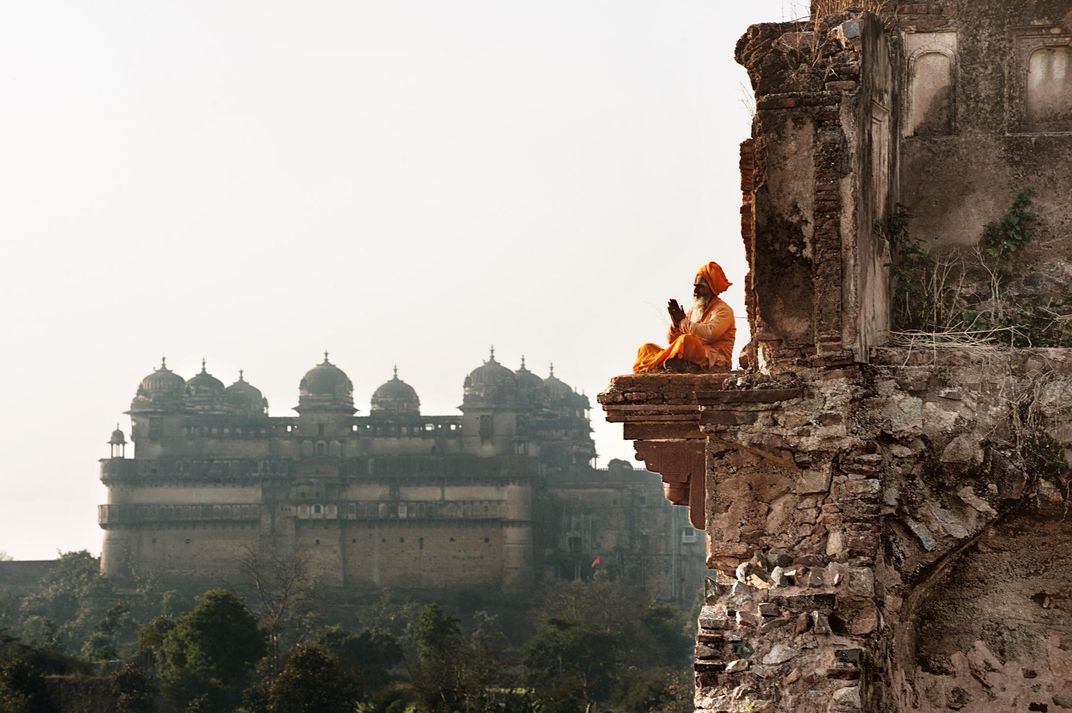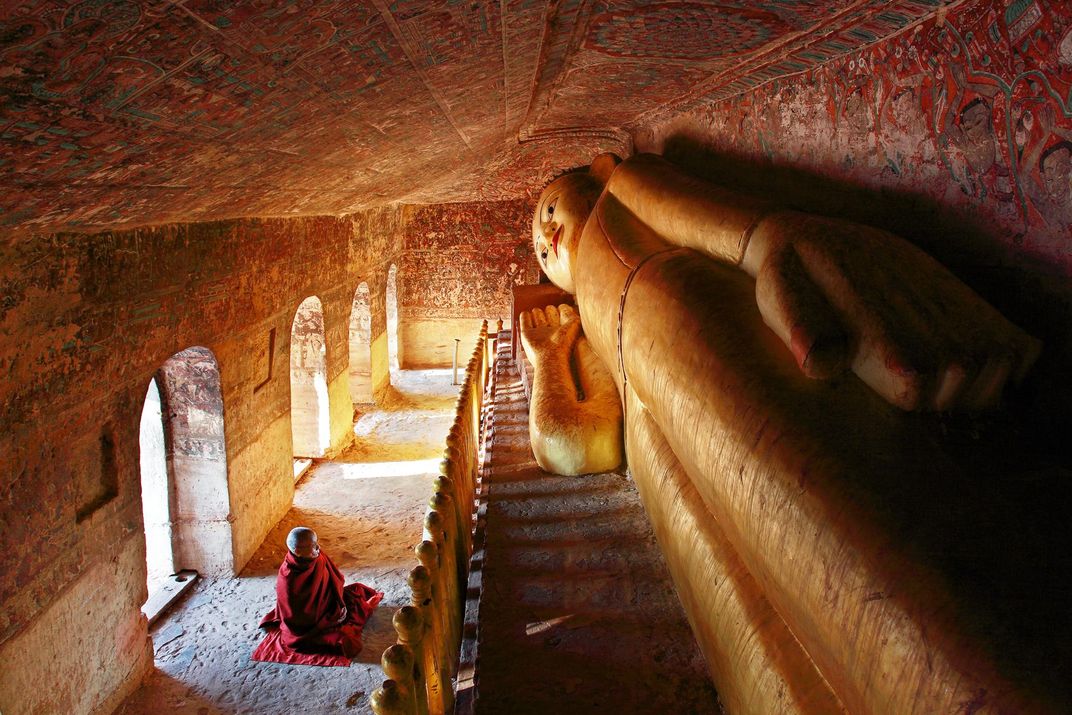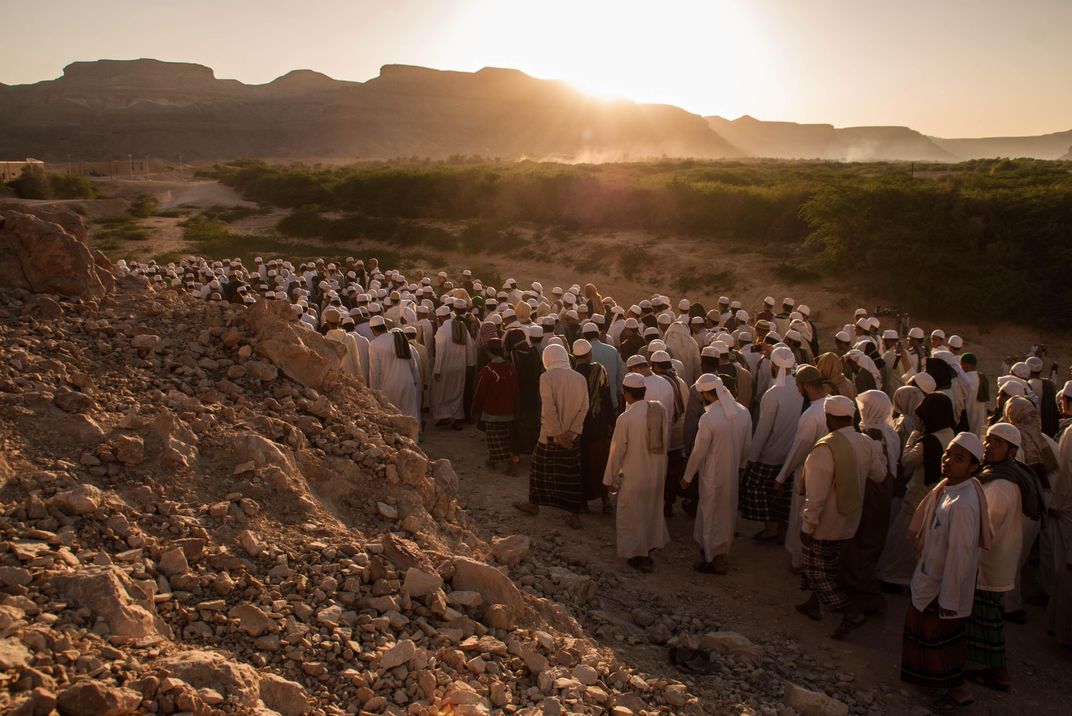Pope Francis Is Just the Latest to Bridge the Gap Between Religion and Culture
A Smithsonian curator offers a primer to the complex role of the world’s religions in meeting the challenges of global climate change
/https://tf-cmsv2-smithsonianmag-media.s3.amazonaws.com/filer/9d/b5/9db54b2a-606f-4e19-bcc6-62973a62af0f/42-77251088.jpg)
On September 2, from Saint Peter’s Basilica, Pope Francis issued a call to take care of the Earth. He asked God to enlighten "those who hold power and money so that they avoid the sin of indifference.” This comes on the heels of the watershed moment earlier this year, when the Pope released his 184-page papal encyclical, soliciting swift action on climate change.
It may seem that his appeal to the world’s people to do something, and do something soon, about global climate change comes late to the cause. But in a world dominated by the market economy, where “growth” and “development” are defined in monetary terms, religion plays an uneasy and diminishing role in refereeing this looming planetary crisis.
The core messages of a religion along with its cultural context create a significant tension with this issue and in fact, play a role in how practitioners view the subject of human-caused climate change. Given that today and especially in the United States, a religious practice is seen as something one chooses to do, regardless of one’s culture, here is a brief map to help us understand how religion and culture interact.
The Emergence of Religion
In traditional pre-urban societies, no marketplace of faiths existed as it does today. Living close to the environment, and in response to spiritual experiences of gifted individuals—shamans, for example—communities developed understandings, practices and rules of behavior governing the relationship between humanity and the natural and spiritual worlds. “Religion” was not separate from other aspects of cultural life.
As larger and more complex civilizations emerged, societies became more stratified, allowing for the emergence of a ruling class, and with that, a priestly class and a state religion.
The great civilizations of ancient Meso-America, Egypt and the Near East fit this model, with religion intertwined with political leadership, national ceremonial life and monumental architecture. The more powerful the government, the more likely that it would incorporate religion to justify its existence. In Europe, the “divine right of kings” gave religious justification to absolute monarchy during the 17th and 18th centuries.

In these intellectually inquisitive and scholarly environments, aided by the advent of writing, there was room for new thinking and new revelations. So in Hellenistic-period Athens, for example, with its Olympian gods, there also emerged the Stoics and their opposites the Epicureans, along with religions and religious influences from Egypt. Within the Roman Empire, individual seekers had their own encounters with the Ineffable, and spread the word—sometimes accruing followers and creating lasting religions such as Christianity, with others making less of a mark, like Manichaeism, which spread widely between the third and seventh centuries and briefly rivaled Christianity, only to fade away altogether.
Community vs. Universalizing Religions
Because these new kinds of religions have quite different characteristics from those beliefs and practices of pre-urban (or non-urban) communities, scholars have long recognized two general categories of religion: a traditional “community religion” that has little or no formal organization but is integral to aspects of common life; and the more formal, or “universalizing religions,” that arose from individual revelations and became institutions with wide arrays of followers.
In community religions, the practices and beliefs are inseparable from the culture of the group, and the focus tends to be on maintaining balance and harmony—within the community and between it and the natural and spiritual worlds. The myriad indigenous systems of the world fall into this category, from American Indians to tribal Southeast Asians. European scholars for a long time refused to even classify these as “religion.” Rather, they were “primitive beliefs.”
Universalizing religions are religions that anyone can join, regardless of race, gender, class, language and so on. They have scriptures (which makes them transportable), they focus on individual salvation, and they tend to have missionaries or proselytizers who encourage non-adherents to join. Christianity, Islam and Buddhism are placed into this category.
No matter the distinction, there is one basic principle at work—the two opposing aspects of human nature—the selfish and the spiritual. Our ego-biological nature is our “selfishness” and promotes self-preservation and preservation of the family; and includes personal pleasure and personal gain.
The spiritual nature, conversely, incorporates our “selflessness.” By letting go of things—everything, including the ego—one can experience one’s true nature as a part of Divinity. Thus one can find in most all religions admonitions against stealing, lying, killing, possessiveness and other weaknesses or harmful, selfish acts. And in universalizing religions, the founder designates the path for others to follow in order to achieve divine realization.
Unfortunately, the tension between these two aspects of the self makes following that path very difficult. Hence “many are called, few are chosen."
Most people make do with a limited degree of adherence to those guidelines, and otherwise focus on raising their families, doing their jobs and living ordinary lives.
Each major world religion, however, has its small groups that really try to do what the founder instructed—monks, nuns, yogis, Sufis, Kabbalists. They renounce the world to follow the path. Everyone else is a lay person. And here is where institutionalized religion comes in, and with it, the role of culture.
The Trajectory of a Universalizing Religion:
Because universalizing religions spread beyond the core group to far-flung regions and peoples, they have a very different relationship to culture than community religions.

The trajectory goes something like this. An individual experiences the Ineffable, then teaches about it. Those teachings become scripture or doctrine. A formal organization arises, usually after the founding teacher is gone. The organizations then become the mediators that interpret the original teachings. Differences over interpretations lead to divisions within the organization, and new organizations split off, nominally of the same religion but adhering to different beliefs and practices.
As the religion spreads, it intermixes with local culture to take on new meanings, interpretations and practices that are acceptable to the local people. As the values of those cultures change, the religion adapts to those changes (however slowly and reluctantly). In all cases, these sets of beliefs and practices influence how the members approach issues of the human condition—poverty, social justice, gender equality, environmental justice and so forth.
So a religion that is thousands of years old is different from what its adherents practiced at the beginning, especially in regions outside the original homeland. The admixture with local cultures, then the evolution of cultural values, ideas and technologies, as well as the influx of new ideas from outside, push these changes.
For example, Christianity—a Middle Eastern religion—came to the Hawaiian islands in the 1820s via Congregationalist missionaries from New England, where two centuries earlier Protestants from England had planted themselves to avoid religious persecution. For these New Englanders, Christianity was inextricably linked with culture. Hence they insisted that Native Hawaiians be dressed in Western clothing, live in Western-style houses, eat with knives and forks, and work eight-hour days. None of this made sense to the Hawaiians, but they adopted many of these practices under the stern command of religious authority, though many strove to retain practices and beliefs from their own indigenous tradition.
Religion and Modernity
Inasmuch as culture has always reshaped universalizing religions as they moved over time and space, the massive cultural transformations brought on by modernity have posed much more intense challenges. The tension between the values of modernity and the teachings of religion is exemplified by the birth rates in the wealthier Catholic countries. Despite the church’s admonitions against contraception, the birthrate in Italy (where the Vatican resides) is the third lowest in the world. Why? Because in modern society, children are an economic burden, not the economic benefit they were in a peasant agrarian society.
In the United States, the religious passion that characterized the earlier centuries began to fade as economies shifted from agriculture to industrialization. Previously, the Protestant ethic and the Puritan temper, which fueled the growth of the market economy in the 18th and 19th centuries, held that in this empty, material world, we needed to work hard to prove our divine worth.
Gratification was to be postponed, for it would come in the afterlife. In other words, it’s good to make a lot of money, but not to live lavishly. Rather, that wealth should be used for the good of the society as a whole. One should be frugal.
But producing wealth through mass production (made possible by the Industrial Revolution) requires that there also be mass consumption so that the products are purchased, and mass consumption made other-worldly gratification seem less relevant to pleasure in the here and now, especially as incomes rose.
In moderation, there’s nothing wrong with that. But the needs of an expanding market means people need to buy more. And this both fueled and was fueled by the selfish side of human nature. As one tongue-in-cheek slogan goes, “I shop, therefore I am.”

Thus not only has core religious messages of self-less-ness falling prey to the cultural and economic forces of self-ish-ness, but this trend is actually fostered as a positive value—one, even, that needs to be defended against “heretics” who might suggest we should all lead simpler, more sustainable lifestyles.
Hence at the outset of the 1992 Earth Summit in Rio de Janeiro, United States President George H.W. Bush famously declared: “The American way of life is not up for negotiations. Period.”
Moreover, religious organizations, like any other organisms, too often end up working to ensure their self-preservation rather than focusing on the perpetuation of the original message. Some religious leaders and institutions take up social and political ideologies that foster enmity towards certain groups of people.
Some religious believers of different persuasions hate, fight and even kill each other. Some religious leaders fall prey to corruption. And so on. The original teaching—the path of selflessness that can lead to the experience of the Ineffable—can have a hard time remaining front and center amidst all these forces. Two scholars at Yale, Mary Evelyn Tucker and John Grim, sum up this tension:
“It must be recognized that the world’s religions, through intolerance and exclusive claims to truth, have often contributed to tensions between peoples, including wars or forced conversion. It is also the case that religions have often been at the forefront of reforms, such as in the labor movement, in immigration law, in justice for the poor and oppressed. The movements of non-violence for freedom in India and for integration in the United States were inspired by religious principles and lead by religious leaders.”
Facing Responsibility
It’s a no-brainer for community religions that climate change would be linked to human behavior, since they understand a clear and causal human-environment link mediated by the spirit world. Hence sherpas living high in the Himalayas and Paqos seers in the Andes attribute climate change (as manifesting in the melting of glaciers) to some moral imbalance in human society.
And from the Mystic Lake Declaration written by the Native Peoples Native Homelands tribal climate change workshop in Shakopee, Minnesota:
“We have the power and responsibility to change. We can preserve, protect, and fulfill our sacred duties to live with respect in this wonderful Creation. However, we can also forget our responsibilities, disrespect Creation, cause disharmony and imperil our future and the future of others….We are committed to development of economic systems that enable life-enhancement as a core component. We thus dedicate ourselves to the restoration of true wealth for all Peoples. In keeping with our traditional knowledge, this wealth is based not on monetary riches but rather on healthy relationships, relationships with each other, and relationships with all of the other natural elements and beings of creation.”
But the genuine light of universalizing religion does shine. That is what we see happening now. Pope Francis has been the most visible in this regard, but he is far from alone. The Forum on Religion and Ecology at Yale provides climate change statements from world religions, including some indigenous traditions. While there are different flavors to these statements, the basic principles are plainly seen: humankind must act in ways that are responsible to each other, to the earth that sustains us, and to our future generations. They urge environmental stewardship, reduced consumption and a calling to live simpler lives. They urge the people of this Earth, and their governments to take action.
From the Buddhist statement:
“Instead of an economy that emphasizes profit and requires perpetual growth to avoid collapse, we need to move together towards an economy that provides a satisfactory standard of living for everyone while allowing us to develop our full (including spiritual) potential in harmony with the biosphere that sustains and nurtures all beings, including future generations.”
From the Hindu statement:
“Humanity’s very survival depends upon our capacity to make a major transition of consciousness, equal in significance to earlier transitions from nomadic to agricultural, agricultural to industrial and industrial to technological. We must transit to complementarity in place of competition, convergence in place of conflict, holism in place of hedonism, optimization in place of maximization.”
From the Islamic Statement:
“Our species, though selected to be a caretaker or steward (khalifah) on the earth, has been the cause of such corruption and devastation on it that we are in danger of ending life as we know it on our planet. This current rate of climate change cannot be sustained, and the earth’s fine equilibrium (mīzān) may soon be lost. As we humans are woven into the fabric of the natural world, its gifts are for us to savour….But our attitude to these gifts has been short-sighted, and we have abused them. What will future generations say of us, who leave them a degraded planet as our legacy? How will we face our Lord and Creator?”
From the Christian Evangelical Statement:
“Christians, noting the fact that most of the climate change problem is human induced, are reminded that when God made humanity he commissioned us to exercise stewardship over the earth and its creatures. Climate change is the latest evidence of our failure to exercise proper stewardship, and constitutes a critical opportunity for us to do better.”
From the Quakers:
“We recognize the connections between climate change and global economic injustice as well as unprecedented levels of consumption, and question assumptions of unlimited material growth on a planet with limited natural resources….We seek to nurture a global human society that prioritizes the well-being of people over profit, and lives in right relationship with our Earth; a peaceful world with fulfilling employment, clean air and water, renewable energy, and healthy thriving communities and ecosystems.”
What we face with climate change is a radical confrontation between the culture that has produced wealth and comfort, and the religious traditions that have taught us to selflessly work in balance with all of creation. It is for this reason that Pope Francis’s recent remarks have earned him the dubious distinction of “The Most Dangerous Person On The Planet.” What was originally religious doctrine has become cultural heresy.
But as the Islamic Statement notes, “If we each offer the best of our respective traditions, we may yet see a way through our difficulties.” It is up to each individual to heed the exhortation of the Pope and all the great religious thinkers of the world, and bring our hearts and minds together to make this happen.
/https://tf-cmsv2-smithsonianmag-media.s3.amazonaws.com/accounts/headshot/Doug-BPBM-2011.jpg)
/https://tf-cmsv2-smithsonianmag-media.s3.amazonaws.com/accounts/headshot/Doug-BPBM-2011.jpg)